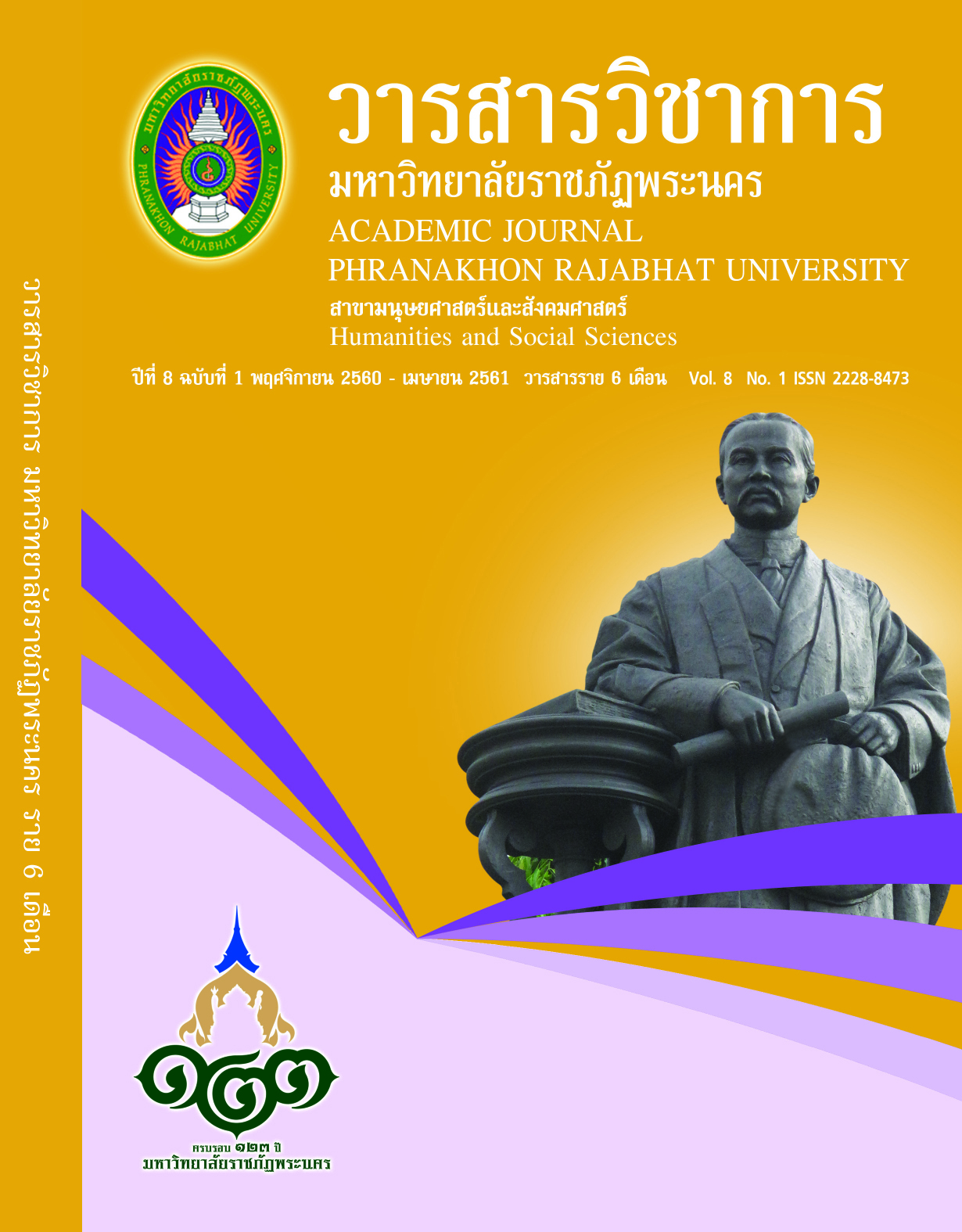ความคล่องตัวโซ่อุปทานและความหยุ่นตัวโซ่อุปทาน: การนำไปใช้สำหรับโซ่อุปทานอุตสาหกรรมคอมพิวเตอร์ในประเทศไทย
Keywords:
Supply Chain Agility, Supply Chain Resilience, Supply Chain managementAbstract
The purposes of this research were to study 1) To identify and classify between Supply Chain Agility(SCA) and Supply Chain Resilience (SCR), which are commonlystrategy applied in the supply chain of computer industry in Thailand.2) To study the relationships among Agility, Resilience, and Firm's performanc (FP) in the supply chain of computer industry in Thailand.3) To identify and examine the differences across organizational characteristics on Agility, Resilience, and Firm's performanc an implementation in the organiztion.By using to mixed of research methodology, among qualitative and quantitative methods. For qualitative method using deep interview for collecting insights from manufacturers and distributors in the computer industry in Thailand in order to obtain quality information, from 6 companys and 12 population. And quantitative method using the questionnaires totals 560 companys and 1,120 populations, with stratified random sampling, data analyze by various statistical techniques to ensure reliability and validity in structural equation modeling (SEM)
The findings found that, 1)SCR has commonly strategy applied in the supply chain of computer industry in Thailand. But it consider from indirect effect found that, SCR has appropriate. However, SCR has positive effect directly and indirectly to FP, which better than.2) Found that relationships on positive effect directly among SCA and SCR, SCR and FP. Furthermore, found that indirect effect among SCR and SCA, SCA and FP, SCR and FP.3) Found backward relationship among SCA and SCR, including, if apply SCA and SCR in parallel, will be strong positive effect to FP.
References
กระทรวงอุตสาหกรรม. (2556), "รายงานภาวะเศรษฐกิจอุตสาหกรรมรายไตรมาส", สำนักงานเศรษฐกิจอุตสาหกรรมกระทรวงอุตสาหกรรม, หน้า 1-206.
กระทรวงแรงงาน. (2556), อัตราค่าจ้างขั้นต่ำ, ที่มา: http://lb.mol.go.th, เข้าถึงเมื่อ 10 กันยายน 2556.
วอยซ์ทีวี. (2556), ยอดขาย 'พีซี' ตกต่อเนื่องนานสุดเป็นประวัติการณ์, ที่มา: http://news.voicetv.co.th/global/75175.html, เข้าถึงเมื่อ 15 กันยายน 2556.
Boyle, T.A., Scherrer-Rathje, M. and Stuart, I. (2008). “Learning to be lean: The influence of
external information sources in lean improvements”, Journal of Manufacturing Technology
Management, Vol. 22, No. 5, pp. 587–603.
Braunscheidel, M.J. and Suresh, N.C. (2009), “The organizational antecedents of a firm’s supplychain agility for mitigation and response”, Journal of Operations Management, Vol. 27 No. 2, pp. 119-40.
Burkett, M., Steutermann, S., Tohamy, N., Rizza, M.N., Jacobson, S.F. and Dwight Klappich, C. (2011), “ Building a Resilient Supply Chain”, Gartner, Inc, No. G00216075, pp. 1-7.
Charles, A., Lauras, M. and Wassenhove, L.V. (2010), “A model to define and assess the agility of supply chains: building on humanitarian experience”, International Journal of Physical. Distribution & Logistics Management, Vol. 40 Nos 8/9, pp. 722-741.
Christopher, M. and Peck, H. (2004), “Building the resilient supply chain”, International Journal of Logistics Management, Vol. 15 No. 2, pp. 1-13.
Dove, R. (1996), “Tools for analyzing and constructing agility”, Agility Forum, PA96-01, Jan 1996. Fisher, M.L. (1997), “What is the right supply chain for your product?”’, Harvard Business Review, March/April, pp. 105-116.
Gligor, D.M. and Holcomb, M.C. (2012), “Understanding the role of logistics capabilities in achieving supply chain agility: a systematic literature review”, Supply Chain Management: An International Journal, Vol. 17 No. 4, pp. 438–453.
Guiffrida, A.L. and Jaber, M.Y. (2008). “Managerial and Economic Impacts of Reducing Delivery Variance in the Supply Chain”, Applied Mathematical Modeling, Vol. 32 No. 10, pp.2149-2161.
Gorman, C., Dale, S.S., Grossman, W., Klarreich, K., McDowell, J. and Whitaker, L. (2005), “The importance of Resilience,”Time Canada, Vol.165, No.3, pp. 79.
Ju¨ttner, U. and Maklan, S. (2011), “Supply chain resilience in the global financial crisis: an empirical
study“, Supply Chain Management: An International Journal, Vol. 16 No. 4, pp. 246–259.
Kull, T. and Closs, D. (2008), “The risk of second-tier supplier failures in serial supply chains:
Implications for order policies and distributor autonomy”, European Journal of Operational Research, Vol. 186, pp. 1158-1174.
Lee, H.L. (2004), “The triple-A supply chain”, Harvard Business Review, Vol. 82 No. 10, pp. 2-12.
Li, X., Chung, C., Goldsby, T.J. and Holsapple, C.W. (2008),“A unified model of supply chain
agility: the work-design perspective”, International Journal of Logistics Management, Vol. 19 No. 3, pp. 408-435.
Manuj, I. and Mentzer, J.T. (2008), “Global supply chain risk management strategies,” International
Journal of Physical Distribution & Logistics Management, Vol. 38 No. 3, pp. 192-223.
Merschmann, U. and Thonemann, U.W. (2011), “Supply chain flexibility,uncertainty and firm
performance An empirical analysis of manufacturingfirms”, Int. J.Production Economics, Vol. 130, pp. 43-53.
Ngai, E.W.T., Chau, D.C.K. and Chan, T.L.A. (2011), ”Information technology, operational, and
management competencies for supply chain agility: Findings from case studies”, The Journal of Strategic Information Systems, Vol. 20 No. 3, pp. 232-249.
Pettit, T.J., Croxton, K.L. and Fiksel, J. (2013), “Ensuring Supply Chain Resilience: Development
and Implementation of an Assessment Tool”, Journal of Business Logistics, Vol. 34 No.
1, pp.46 -76.
Oliver, R. (1993), “Cognitive, affective, and attribute bases of the satisfaction response”, Journal
of Consumer Research, Vol. 20, pp. 418-30.
Swafford, P.M., Ghosh, S. and Murthy, N.N. (2006), “A framework for assessing value chain agility”,
International Journal of Operations & Production Management, Vol. 26 No. 2, pp. 118-140.
Thun, J. and Hoenig, D. (2011), “An empirical analysis of supply chain risk management in the
German automotive industry”, International Journal of Production Economics, Vol. 131
No. 1, pp. 242-9.
Tieman,M., van der Vorst, J.G.A.J. and Che Ghazali, M. (2012), “Principles in halal supply chain management”, Journal of Islamic Marketing, Vol. 3 No. 3, pp. 217-243.
van Hoek, R.I., Harrison, A. and Christopher, M. (2001), “Measuring agile capabilities in the supply
chain”, International Journal of Operations & Production Management, Vol. 21 Nos 1/2, pp. 126-147.
Wagner, S.M. and Bode, C. (2008), “An empirical examination of supply chain performance along
several dimensions of risk”, Journal of Business Logistics, Vol. 29 No. 1, pp. 307–325.
Wieland, A. and Wallenburg, C.M. (2012), “Dealing with supply chain risks Linking risk management
practices and strategies to performance”, International Journal of Physical Distribution & Logistics Management, Vol. 42 No. 10, pp. 905.
Whitten et al. (2012). Yauch, C.A. (2011), “Measuring agility as a performance outcome”, Journal of Mfg. Technology
Management, Vol. 22 No. 3, pp. 384-404.
Downloads
Published
How to Cite
Issue
Section
License
"บทความวิชาการในวารสารฉบับนี้ ถือเป็นความรับผิดชอบของผู้เขียนเท่านั้น"
สงวนลิขสิทธิ์ตามพระราชบัญญัติลิขสิทธิ์




